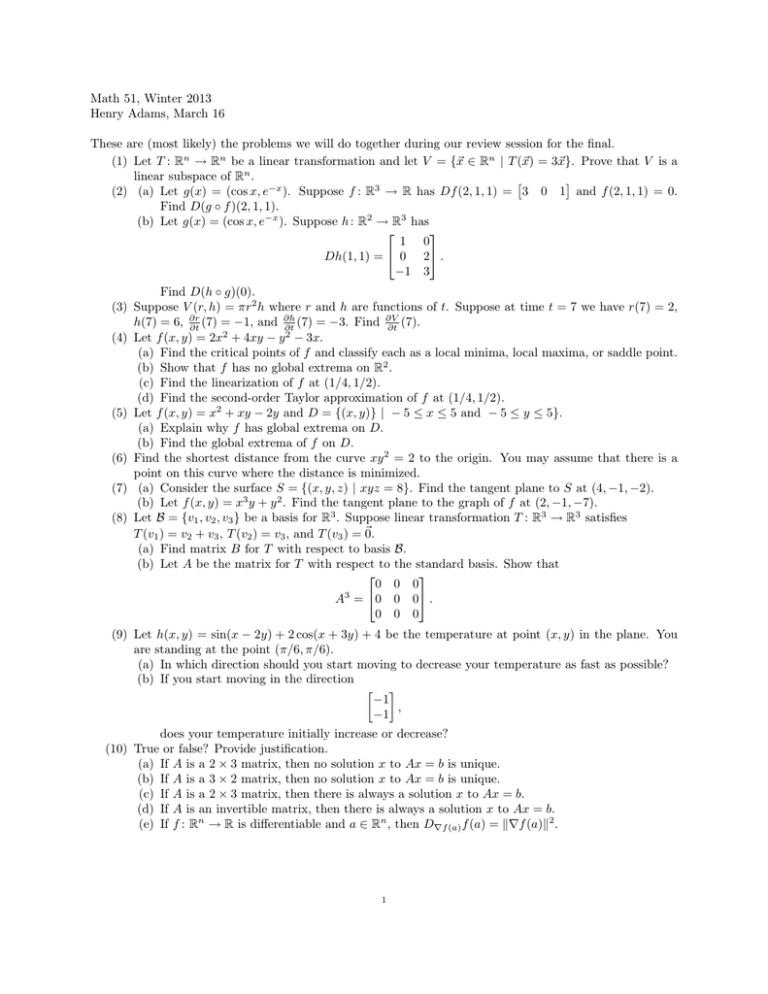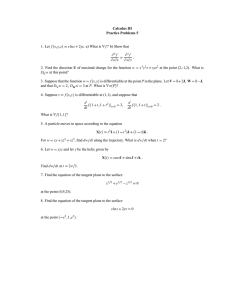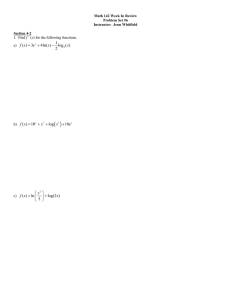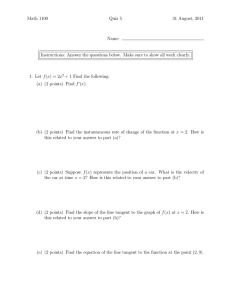Math 51, Winter 2013 Henry Adams, March 16
advertisement

Math 51, Winter 2013
Henry Adams, March 16
These are (most likely) the problems we will do together during our review session for the final.
(1) Let T : Rn → Rn be a linear transformation and let V = {~x ∈ Rn | T (~x) = 3~x}. Prove that V is a
linear subspace of Rn .
(2) (a) Let g(x) = (cos x, e−x ). Suppose f : R3 → R has Df (2, 1, 1) = 3 0 1 and f (2, 1, 1) = 0.
Find D(g ◦ f )(2, 1, 1).
(b) Let g(x) = (cos x, e−x ). Suppose h : R2 → R3 has
1 0
Dh(1, 1) = 0 2 .
−1 3
Find D(h ◦ g)(0).
(3) Suppose V (r, h) = πr2 h where r and h are functions of t. Suppose at time t = 7 we have r(7) = 2,
∂h
∂V
h(7) = 6, ∂r
∂t (7) = −1, and ∂t (7) = −3. Find ∂t (7).
2
2
(4) Let f (x, y) = 2x + 4xy − y − 3x.
(a) Find the critical points of f and classify each as a local minima, local maxima, or saddle point.
(b) Show that f has no global extrema on R2 .
(c) Find the linearization of f at (1/4, 1/2).
(d) Find the second-order Taylor approximation of f at (1/4, 1/2).
(5) Let f (x, y) = x2 + xy − 2y and D = {(x, y)} | − 5 ≤ x ≤ 5 and − 5 ≤ y ≤ 5}.
(a) Explain why f has global extrema on D.
(b) Find the global extrema of f on D.
(6) Find the shortest distance from the curve xy 2 = 2 to the origin. You may assume that there is a
point on this curve where the distance is minimized.
(7) (a) Consider the surface S = {(x, y, z) | xyz = 8}. Find the tangent plane to S at (4, −1, −2).
(b) Let f (x, y) = x3 y + y 2 . Find the tangent plane to the graph of f at (2, −1, −7).
(8) Let B = {v1 , v2 , v3 } be a basis for R3 . Suppose linear transformation T : R3 → R3 satisfies
T (v1 ) = v2 + v3 , T (v2 ) = v3 , and T (v3 ) = ~0.
(a) Find matrix B for T with respect to basis B.
(b) Let A be the matrix for T with respect to the standard basis. Show that
0 0 0
A3 = 0 0 0 .
0 0 0
(9) Let h(x, y) = sin(x − 2y) + 2 cos(x + 3y) + 4 be the temperature at point (x, y) in the plane. You
are standing at the point (π/6, π/6).
(a) In which direction should you start moving to decrease your temperature as fast as possible?
(b) If you start moving in the direction
−1
,
−1
does your temperature initially increase or decrease?
(10) True or false? Provide justification.
(a) If A is a 2 × 3 matrix, then no solution x to Ax = b is unique.
(b) If A is a 3 × 2 matrix, then no solution x to Ax = b is unique.
(c) If A is a 2 × 3 matrix, then there is always a solution x to Ax = b.
(d) If A is an invertible matrix, then there is always a solution x to Ax = b.
(e) If f : Rn → R is differentiable and a ∈ Rn , then D∇f (a) f (a) = k∇f (a)k2 .
1



